Three common adhesive, light-reflective materials were examined: 3M Scotchlite SOLAS-A reflective tape, ACRs Res-Q reflective patches, and 3Ms Scotch-brand reflective adhesive tape. Kitchen aluminum foil was also tested. But being a good reflector of light does not necessarily mean that a material is a good reflector of radar. What makes a good reflector of radar? First, the object must be made of something that is a good conductor of electricity, aluminum for example. Second, the object should be flat. Curved surfaces such as spheres do not reflect radar nearly as well as fl at plates. Third, the surface must be smooth. Surface ripples as small as 1 millimeter can reduce radar reflectivity by as much as 50 percent. And, the dimensions of the object must be at least as long as the radar wavelength. (The wavelength of X-band marine radar is about 1 inches.) It is likely that any light-reflective tape that is relatively stiff, looks metallic, and has no visibly noticeable pattern would be a good choice, but that cannot be guaranteed.
****
Several retroreflective tapes and patches are available in chandleries and some hardware stores. These are designed and sold as efficient reflectors of light, and they are commonly applied to PFDs, life rafts, foul weather gear, etc., to improve nighttime visibility. It has occasionally been suggested that they could be applied to objects to improve their radar signature. It has even been suggested that retroreflective tape be added to the luff of a headsail to serve as a radar reflector. However, being a good reflector of light does not necessarily mean that a material is a good reflector of radar.

Practical Sailor recently had the opportunity to examine several light-reflective materials for their radar-reflective properties, with results that should be of interest to sailors.
What We Tested
Three adhesive, light-reflective materials were examined. The 3M Scotchlite SOLAS-A reflective tape is available at most chandleries. It comes in rolls or 4-inch-by-2-inch adhesive patches, and costs about 27 cents per square inch. ACR Res-Q reflective patches, also stocked by chandleries, come in 4-inch-by-4-inch adhesive patches, and cost about 30 cents per square inch. The third reflective material tested was a 3M Scotch-brand reflective adhesive tape (silver, catalog number 198NA) sold in hardware stores. This comes in 1-inch-by-40-inch adhesive rolls at a cost of 9 cents per square inch. Kitchen aluminum foil, 4 per square inch, was also tested.
What makes a good reflector of radar? First, the object must be made of something that is a good conductor of electricity, aluminum for example. Second, the object should be flat. Curved surfaces such as spheres do not reflect radar nearly as well as flat plates. Third, the surface must be smooth. Surface ripples as small as 1 millimeter can reduce radar reflectivity by as much as 50 percent. And, the dimensions of the object must be at least as long as the radar wavelength. The wavelength of X-band marine radar is about 1 inches (32 millimeters), and objects much smaller than this are not good X-band reflectors. Radar reflectivity is specified numerically by the radar cross-section (RCS). The radar cross-section indicates how much of the power in the pulse that hits the object is reflected back toward the radar. Larger RCS means more power is reflected to the radar and there is greater likelihood that the object is detected. By convention, RCS is measured in square meter.
The Targets
The adhesive tapes were applied to foam board targets for testing. These targets were trihedrals with three 4-inch square plates at right angles to one another. Trihedral targets were used because the theoretical response is well-known, and alignment of the target with the radar beam is not critical. The 4-inch size was selected because it simplified covering the square plates with the test materials, which came in 1-, 2-, and 4-inch sizes. The test materials were each applied to a plate to create three targets. One target was left without any covering to verify that the foam board did not reflect X-band radar waves by itself. Kitchen aluminum foil was glued to the plates of a fifth target. Testers calculated the radar cross-section of a 4-inch square trihedral made of electrically conducting metal plates, perfectly flat with perfectly smooth surfaces. This benchmark was used for evaluating the test targets.
What We Found
Plain foam board.
No reflection from the plain foam board was measured, indicating that the targets themselves are transparent to radar and had no effect on the measurements.
3M Scotch reflective tape.
The measured RCS is almost ideal. Given the problems with aluminum foil (see below) and the other two reflective tapes, the beneficial aspects of the 3M tape seem to be its even, nonpatterned surface and the fact that it is relatively stiff, so that the surface is quite smooth when it is applied to the target. The 3M tape is essentially as reflective as possible. This is noteworthy because the reflective tape is sold as a reflector of light, with no claims that it is a radar-reflective material.

Aluminum foil.
Even though aluminum foil is a good electrical conductor, the measured RCS was slightly below the benchmark value. The decreased RCS is readily explained by the bumpy texture of the foil as it was difficult to achieve a perfectly smooth surface when gluing the foil to the foam board backing.
ACR Res-Q patch.
The return on the ACR material tested was rather poor. The poor performance was likely due to the distinct pattern in the ACR patch, which is far from being smooth and uniform.
SOLAS-A patch
. The SOLAS-A tape produced a detectable but extremely small response. The tape consists of numerous small hexagonal patches 4-millimeters across. The individual reflective hexagons in the SOLAS-A patch are tiny compared to the 31.9-millimeter X-band wavelength and do not reflect radar pulses well at all. If the individual hexagons are nearly invisible, the whole patch is nearly invisible to radar. This result is important because SOLAS-A tape is one of the candidates sometimes suggested to be used for radar reflectivity, and it shouldnt be.
Radar Detection Range
The RCS numbers for the various materials and targets are of interest to the engineer. Detection range is more useful to the sailor. The above chart shows the relative ranges at which the different materials tested will be detected. Assume that identical targets such as our test trihedrals are made of the different materials. Also assume that the radar is adjusted so that the benchmark target is detected at 1,000 meters (or yards, if you prefer). The chart shows the ranges at which the different targets will be detected. You can see that the detection range for the 3M Scotch brand tape and aluminum foil are essentially ideal, whereas the detection range for the ACR patch is poor and that of the SOLAS-A tape is extremely poor in comparison.
Conclusions
It must be reiterated that the experiments described here dealt with reflectivity of materials at marine radar higher resolution X-band frequencies. (Lower resolution S-band radar, which cuts through fog and rain clutter better, would theoretically yield less effective returns). The three retroreflective tapes examined in this study are designed and sold as reflectors of light, not radar. Measurements of their efficacy as radar-reflective fabrics have no bearing on their efficacy as reflectors of light. Second, the tested materials were applied to flat plates for testing. What would happen if the materials were applied to curved surfaces such as sails, PFDs, foul weather gear, and life rafts was not examined.
That being said, if one is looking for an adhesive tape or patch to put on something to provide a radar signature, one should avoid the SOLAS-A tape. The ACR Res-Q patch should also be avoided because, although it does provide some radar reflectivity, much better materials are available. Aluminum foil is a good inexpensive material, but it is not practical because its fragile and difficult to apply smoothly. The obvious choice is the 3M Scotch-brand reflective tape (silver, Cat 198NA) sold in hardware stores. It is likely that any light-reflective tape that is relatively stiff, looks metallic, and has no visibly noticeable pattern would be a good choice, but that cannot be guaranteed without further testing.




































Why not just use stainless steel plates? Also, how is this attached to a boat?
I tried to find 3M Scotch-brand reflective adhesive tape (silver, catalog number 198NA) with no luck. I also searched 3M website and found
Stainless steel tape https://www.3m.com/3M/en_US/p/c/tapes/foil/stainless-steel/?Ntt=relective%20tape
and 73 aluminum tapes.
Can you provide a bit more guidance for me to find the right 3m tape product?